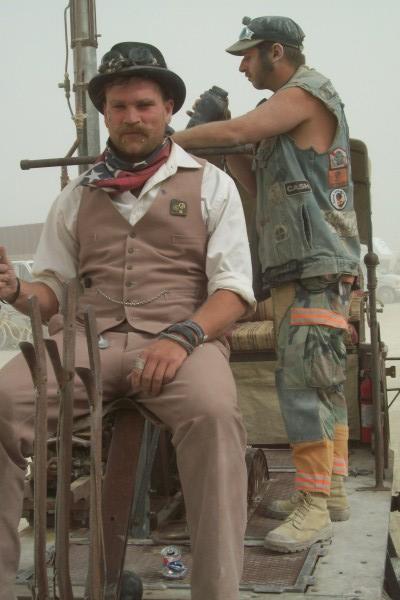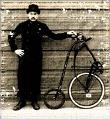Words cannot describe this place. The closest comparison I can make is to the set of Waterworld, on land in Bladerunner world, designed by the lost boys from Peter Pan, managed by Doozers from Fraggle Rock, and staffed by Vulcan and his cyclops minions from The Adventures of Baron Munchausen. It was a large junkyard, maybe five square miles (I never saw the end of it), with only a few streets running through it, and little tin shops crammed in between towering piles of scrap where people were either making something metal, destroying something metal, or selling the tools and hardware that are required to do those two things.
Cracks between buildings that I would have never thought to squeeze down were major thoroughfares. Emungous chunks of machinery- such as a giant bulldozer tread or an engine block taller than me from some unfathomably huge vehicle- appeared to have been sitting there for years since the buildings around them had grown up and prevented access by anything large enough to budge them. Tractors were being stripped for parts while next door teams of workers swarmed over a minivan, putting it together. Piles of half-stripped forklifts. Jungles of scrap pipe. The din of a thousand hammers. I know when you picture this in your head you are picturing these shops and piles as distict, with open space in between, but there was no open space. You know in Labyrinth when Sarah wakes up outside the Goblin City in the junkyard? It was like that, only with bigger junk, and people lived and worked there. I keep comparing it to movies because there is nothing in America like this, not that I've ever heard of. Another apt comparison would be any interior shot of a Borg ship from Star Trek.
I was reeling. Most things were being made out of other things. Everyone was welding, grinding, hammering, bolting, smelting, and chopping. How can I call myself a Rat? How dare I claim to chop? I might as well be knitting doilies compared to this place. I was humbled and stunned. I'll go back to take pictures, but they won't do it justice. Even a hundred pictures of a hundred different activities wouldn't do it, because you just wouldn't conceive of the density of those activities. You'd have to do what I did, be led down twisting corridors and around rotting cranes for a mile, and see the thousand activities in action.
I was so stunned and excited that I kept myself composed, but when I got home and was alone I cried. I cried.
I had slipped the surly bonds of earth and touched the face of God. So much beauty, so much creation, so much DOing... I have to stop typing. I have to take a break, because I'm crying again. If you know me you will understand why.
---
We had brought along Patriensa's resident welder. In the car we became fast friends, laughing at the tiny holes burned in both of our clothes. One of the things I've learned from the Rat Patrol is that no matter where you go, if you find someone who does the same thing as you, you will automatically be buddies. When people come to visit from other mutant bike clubs, they click with us like we'd known them all along. This is further evidence for my blossoming theory that activity is driven by something more than choice, and personality is just a manifestation of this internal drive. How else could I travel 6000 miles, drive four hours into the bush, find a guy who barely speaks my language, and already know him? It is interesting to note that this does not work for anybody who is not doing what they truly wish to do. We all have two paths, like a comet's two tails, and the direction they point is determined by the heart and the head. Following your head gets you wealth, security, safety. Following your heart, well, the rewards cannot be expressed in words.
The four of us (the two shoppers, Osei, and Kwaku) ambled (remember, no walking allowed) up and down and through and over and under, asking where we could find welding machines. When we found one, they'd argue about price and we'd walk away (this is essential even if we were going to buy it). The negotiations were performed by Osei, and I was ignored but my presence had a very strong effect on the conversation. Eventually I suggested that I stay back, out of sight, so that they could negotiate without the local equivalent of a gold-laden oil sultan standing behind them, indicating the size of their budget.
The welding machines themselves were amazing. Locally made, of course. I watched a guy clamp strips of metal and something else between two pieces of angle iron connected by threaded rod, while another guy wrapped a completed one in wire. Then you weld a little box out of scrap and drop it in there and fill it with oil. Some were air-cooled and adjusted with a bolt, and some sat in the box of oil and you chose high, medium, or low by attaching your electrode to one of three wire loops. Once again, I felt like a chump for buying my own welder. We bought the latter type for about $50 plus $50 in accessories (things like filler rod and the claaamps, which were not homemade and so they cost just as much) and then went shopping for hardware.
At the 'hardware store' (ha!) I spent more fundraiser money on the things we would need to build bikes- files, hacksaws, a drill, a good welding mask (not one of the wooden church fans with a piece of film in the middle like the people around me used, if they used anything at all), gloves, hose clamps, tube steel, nuts and bolts and washers, tape measure... our bill came to about c900,000.00. For some reason, the smallest unit of currency is c1,000, and the biggest is c5,000. Coins and bigger bills exist but they're just not used. It's like in America, how nothing much costs less than a quarter, and if it does, you probably just buy a quarter's worth of 'em. But imagine dropping $900 at the hardware store and all you've got to pay are Washingtons and quarter-notes. It was such a task just to count the bills out that the proprietor of the shop next door came over to help our shopkeep and her sister count it all. That lady's probably at home right now, drinking a toast to the Obruni who came and spent enough money to live on for 100 days. If you gave at the fundraiser, understand the impact that money has here... a hundred bucks, and she will spend it locally, and I will use the equipment to build these bikes, and the people who learn from me will get a job, and the people who buy them will make money off of them... and so on.
You see, Ghana has a transportation crisis. There is no intermediate level between walking and a car. Teachers make between $50 and $200 a month, but spend $3 a day on a trotro ride to work. Farmers lose their profits to the middlemen, the truck drivers, because the only other option is to load up all their wives' head-baskets and walk the produce to market... an average distance of 5-20 miles. Now, what vehicle is cheap to buy and maintain, and perfect for journeys of less than 20 miles? You see why so many bigwigs are interested in this. We are building a university that teaches the art of bicycle modification. First you learn bike mechanics, then you learn welding, then you learn chopping. Osei is the suit and I am the beard. Our first step is to make as many designs as we can think of (Osei wants 40, including choppers and tallbikes and anything I can imagine), and then we will host a bicycle show and invite the Ministers of Manpower (this will create jobs), Agriculture (this will help farmers), Education (this teaches skills and we're hoping for accreditation), and the Interior (this could help the transportation crisis, plus, his wife said she wants to get all those crops off the women's heads and onto the farmer's bikes, let them do the shlepping). The television crews will come and so will the President if he's available (he's been calling for more bike use lately because so many people are being killed when overcrowded trotros wreck). Hopefully Working Bikes will send a delegation, too, and we can all ride choppers around in the jungle while the bodyguards with machineguns look on.
 The Steampunk World
The Steampunk World


0 Comments:
Post a Comment
<< Home